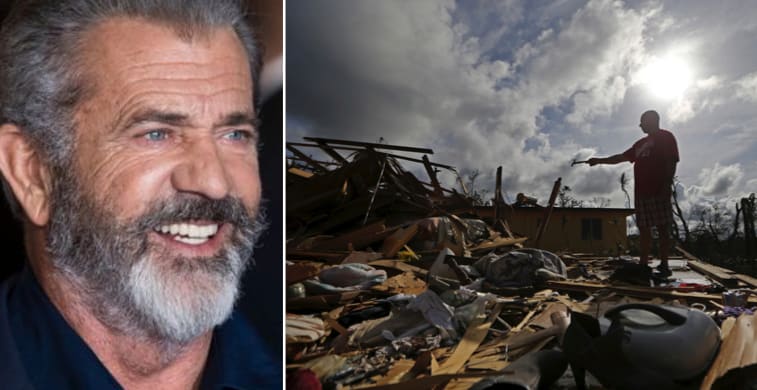
Kritikstorm mot nya Gibson-filmen om orkanen Maria
Kommande filmen ”Force of Nature” om orkanen Maria, som slog till mot Puerto Rico 2017, möter hård kritik på sociala medier, rapporterar flera medier.
I filmen spelar Mel Gibson en man som vägrar lämna sin lägenhet trots att kategori 5-orkanen närmar sig ögruppen. Efter att trailern i måndags offentliggjordes följde en våg av kritiska inlägg om att filmen är både okänslig och rasistisk.
”En Hollywood-film om det mest traumatiska som någonsin hänt i Puerto Rico och så handlar den om en snobbig vit gammal man som vägrar lämna sitt hem, ni skojar”, skriver en person på Twitter.

bakgrund
Orkanen Maria
Wikipedia (en)
Hurricane Maria was a deadly Category 5 hurricane that devastated Dominica, St Croix, and Puerto Rico in September 2017. It is regarded as the worst natural disaster in recorded history to affect those islands and was also the deadliest Atlantic hurricane since Jeanne in 2004. The tenth-most intense Atlantic hurricane on record and the most intense tropical cyclone worldwide in 2017, Maria was the thirteenth named storm, eighth consecutive hurricane, fourth major hurricane, second Category 5 hurricane, and deadliest storm of the hyperactive 2017 Atlantic hurricane season. At its peak, the hurricane caused catastrophic destruction and numerous fatalities across the northeastern Caribbean, compounding recovery efforts in the areas of the Leeward Islands already struck by Hurricane Irma. Total losses from the hurricane are estimated at upwards of $91.61 billion (2017 USD), mostly in Puerto Rico, ranking it as the third-costliest tropical cyclone on record.
Originating from a tropical wave, Maria became a tropical storm on September 16, east of the Lesser Antilles. Highly favorable environmental conditions allowed the storm to undergo explosive intensification as it approached the island arc. The hurricane reached Category 5 strength on September 18 just before making landfall on Dominica, becoming the first Category 5 hurricane on record to strike the island. After weakening slightly due to crossing Dominica, Maria achieved its peak intensity over the eastern Caribbean with maximum sustained winds of 175 mph (280 km/h) and a pressure of 908 mbar (hPa; 26.81 inHg). On September 20, an eyewall replacement cycle took place, weakening Maria to a high-end Category 4 hurricane by the time it struck Puerto Rico. Interaction with land further weakened the hurricane, though it regained some strength as it moved northeast of the Bahamas. Moving slowly to the north, Maria gradually degraded and weakened to a tropical storm on September 28. Embedded in the westerlies, Maria accelerated toward the east and later east-northeast over the open Atlantic, becoming extratropical on September 30 and dissipating by October 2.
Maria wrought catastrophic devastation to the entirety of Dominica, which suffered an island-wide communication blackout. Much of the housing stock and infrastructure were left beyond repair, while the island's lush vegetation was practically eradicated. The islands of Guadeloupe and Martinique endured widespread flooding, damaged roofs, and uprooted trees. Puerto Rico also suffered catastrophic damage and a major humanitarian crisis; most of the island's population suffered from flooding and a lack of resources, compounded by the slow relief process. The storm caused the worst electrical blackout in US history, and in June 2018, thousands of homes and businesses were still without power. Maria was the third consecutive major hurricane to threaten the Leeward Islands in two weeks, after Irma had made landfall in several of the islands two weeks prior and Hurricane Jose passed dangerously close shortly afterward, bringing tropical storm force winds to Barbuda.
On August 28, 2018 (almost a year after the hurricane), Puerto Rico revised its official tally of 64 killed in the hurricane up to 2,975, making the total death toll 3,059: an estimated 2,975 were killed in Puerto Rico, 65 in Dominica, 5 in the Dominican Republic, 4 in Guadeloupe, 4 in the contiguous United States, 3 in the United States Virgin Islands, and 3 in Haiti. Maria is the deadliest hurricane in Dominica since the 1834 Padre Ruíz hurricane and the deadliest in Puerto Rico since the 1899 San Ciriaco hurricane. The death toll in Puerto Rico was initially reported as 64 by Puerto Rican authorities but revised after several studies estimated between 1,400 and 5,740 deaths were attributable to the storm. The official estimate of 2,975 is based on a study commissioned by the governor of Puerto Rico, where researchers at George Washington University developed statistical models of excess mortality attributable to Maria, including both direct and indirect fatalities. Researchers attribute the discrepancy with the initial death count to "lack of awareness of appropriate death certification practices after a natural disaster" among physicians reporting deaths to vital statistic agencies.
Omni är politiskt obundna och oberoende. Vi strävar efter att ge fler perspektiv på nyheterna. Har du frågor eller synpunkter kring vår rapportering? Kontakta redaktionen